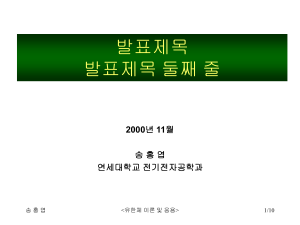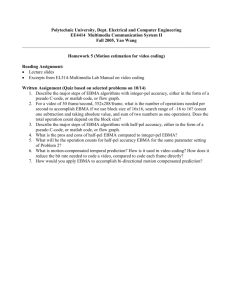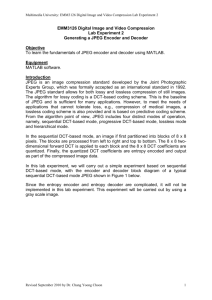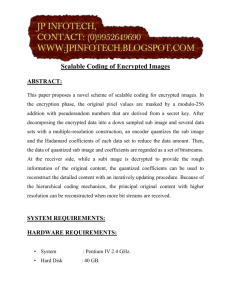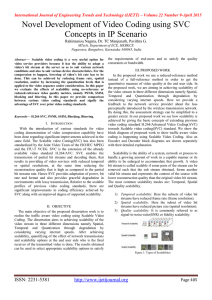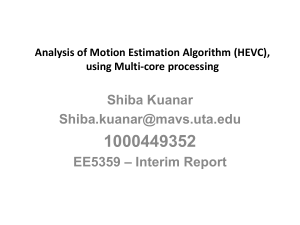Source Coding and Compression Class Project – WS 2013/14
advertisement
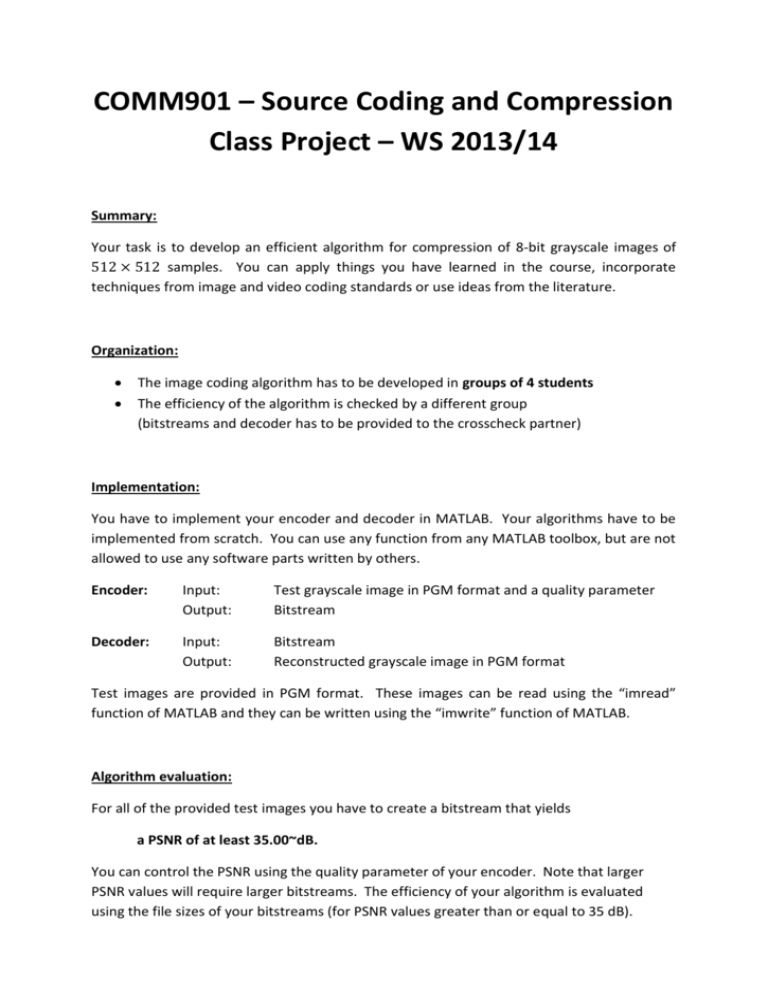
COMM901 – Source Coding and Compression Class Project – WS 2013/14 Summary: Your task is to develop an efficient algorithm for compression of 8-bit grayscale images of samples. You can apply things you have learned in the course, incorporate techniques from image and video coding standards or use ideas from the literature. Organization: The image coding algorithm has to be developed in groups of 4 students The efficiency of the algorithm is checked by a different group (bitstreams and decoder has to be provided to the crosscheck partner) Implementation: You have to implement your encoder and decoder in MATLAB. Your algorithms have to be implemented from scratch. You can use any function from any MATLAB toolbox, but are not allowed to use any software parts written by others. Encoder: Input: Output: Test grayscale image in PGM format and a quality parameter Bitstream Decoder: Input: Output: Bitstream Reconstructed grayscale image in PGM format Test images are provided in PGM format. These images can be read using the “imread” function of MATLAB and they can be written using the “imwrite” function of MATLAB. Algorithm evaluation: For all of the provided test images you have to create a bitstream that yields a PSNR of at least 35.00~dB. You can control the PSNR using the quality parameter of your encoder. Note that larger PSNR values will require larger bitstreams. The efficiency of your algorithm is evaluated using the file sizes of your bitstreams (for PSNR values greater than or equal to 35 dB). The PSNR of 8-bit grayscale image of size is defined by ∑ ∑( [ where [ ] and respectively. [ ] [ ]) ] represent the original and reconstructed image signal, Provided is a Windows executable by which the PSNR between two images in PGM format can be measured. You can also implement your own tool in MATLAB. Test images: Six grayscale test images with a size of samples and a bit depth of 8 bit are used for testing your algorithm. They are provided in PGM format and are shown below. barbara boat clown houses kiel lena Reference for algorithm evaluation: The goal for your image coding algorithm is to provide a coding efficiency that is at least comparable to that of a typical JPEG implementation. It is encouraged to develop an algorithm that is better than JPEG. As a reference, the simulation results for a JPEG implementation are shown in the table below. The JPEG compression was done with the freeware program “Image Magick”; the quality is controlled by a parameter called “JPEG quality”. image barbara boat clown houses kiel lena average JPEG quality 71 70 37 82 82 38 file size [byte] 41 045 36 920 18 574 74 062 59 739 16 960 41 217 PSNR [dB] 35.1273 35.1172 35.0505 35.0817 35.0309 35.0008 35.0681 rel. size 15.66 % 14.08 % 7.09 % 28.25 % 22.79 % 6.47 % 15.72 % Suggestion: Start with an implementation similar to JPEG consisting of block-wise discrete cosine transform scalar quantization (fixed quantization step size for all transform coefficients); the quantization step size can be used as quality parameter entropy coding of quantized transform coefficients (e.g., using zig-zag scanning and run-level coding) This first algorithm can then be later improved by several techniques. Promising techniques may be: Prediction of transform coefficients from neighbouring blocks Block-wise spatial intra prediction Adaptive scanning of transform coefficients Improvements to entropy coding of transform coefficients, such as run-level-last coding Rate-distortion optimized quantization Note: Talk to your lecturer about your ideas. Tell him about your progress and problems. Project submission: MATLAB code for encoder and decoder Bitstream for the test images Presentation slides (10 slides at maximum) The presentation slides have to be provided in pdf or Microsoft PowerPoint format. They should represent the project report and should contain: Description of algorithm Results for test images Who did what Timeline: Wed, Dec 11: Give bitstreams and decoder to your crosscheck partner Fri, Dec 13: Provide your MATLAB code, bitstreams and presentation slides Tue, Dec 17: Presentation of your work during lecture Suggestion: Develop a first working encoder and decoder until November, 19 Project groups: Groups Students Crosscheck Partner (a) (b) Group 1 Group 2 (c) (d) (a) (b) Group 2 Group 3 (c) (d) (a) (b) Group 3 Group 4 (c) (d) (a) (b) Group 4 Group 1 (c) (d)
